Antibody data
- Antibody Data
- Antigen structure
- References [1]
- Comments [0]
- Validations
- Immunocytochemistry [1]
- Immunoprecipitation [1]
- Chromatin Immunoprecipitation [4]
- Other assay [2]
Submit
Validation data
Reference
Comment
Report error
- Product number
- PA5-31919 - Provider product page

- Provider
- Invitrogen Antibodies
- Product name
- SMYD3 Polyclonal Antibody
- Antibody type
- Polyclonal
- Antigen
- Recombinant full-length protein
- Description
- Recommended positive controls: DDDDK-tagged SMYD3-transfected 293T, 293T, A431, HeLa, HepG2, A549, SKOV3, HCT116. Predicted reactivity: Human (99%), Mouse (93%), Rat (94%), Pig (95%), Rhesus Monkey (99%), Bovine (83%). Store product as a concentrated solution. Centrifuge briefly prior to opening the vial.
- Reactivity
- Human, Mouse
- Host
- Rabbit
- Isotype
- IgG
- Vial size
- 100 μL
- Concentration
- 1.23 mg/mL
- Storage
- Store at 4°C short term. For long term storage, store at -20°C, avoiding freeze/thaw cycles.
Submitted references Small molecule inhibitors and CRISPR/Cas9 mutagenesis demonstrate that SMYD2 and SMYD3 activity are dispensable for autonomous cancer cell proliferation.
Thomenius MJ, Totman J, Harvey D, Mitchell LH, Riera TV, Cosmopoulos K, Grassian AR, Klaus C, Foley M, Admirand EA, Jahic H, Majer C, Wigle T, Jacques SL, Gureasko J, Brach D, Lingaraj T, West K, Smith S, Rioux N, Waters NJ, Tang C, Raimondi A, Munchhof M, Mills JE, Ribich S, Porter Scott M, Kuntz KW, Janzen WP, Moyer M, Smith JJ, Chesworth R, Copeland RA, Boriack-Sjodin PA
PloS one 2018;13(6):e0197372
PloS one 2018;13(6):e0197372
No comments: Submit comment
Supportive validation
- Submitted by
- Invitrogen Antibodies (provider)
- Main image

- Experimental details
- SMYD3 Polyclonal Antibody detects SMYD3 protein at cytoplasm by immunofluorescent analysis. Sample: HCT116 cells were fixed in ice-cold MeOH for 5 min. Green: SMYD3 protein stained by SMYD3 Polyclonal Antibody (Product # PA5-31919) diluted at 1:500. Blue: Hoechst 33342 staining.
Supportive validation
- Submitted by
- Invitrogen Antibodies (provider)
- Main image
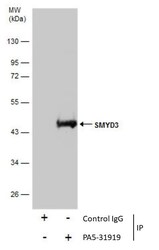
- Experimental details
- Immunoprecipitation of SMYD3 was performed in 293T whole cell extracts using 5 µg of SMYD3 Polyclonal Antibody (Product # PA5-31919). Samples were transferred to a membrane and probed with SMYD3 Polyclonal Antibody as a primary antibody and an HRP-conjugated anti-Rabbit IgG was used as a secondary antibody.
Supportive validation
- Submitted by
- Invitrogen Antibodies (provider)
- Main image
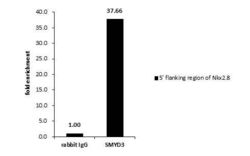
- Experimental details
- Cross-linked ChIP was performed with HepG2 chromatin extract and 5 µg of either normal rabbit IgG or a SMYD3 polyclonal antibody (Product # PA5-31919). The precipitated DNA was detected by PCR with primer set targeting to 5' flanking region of Nkx2.8.
- Submitted by
- Invitrogen Antibodies (provider)
- Main image
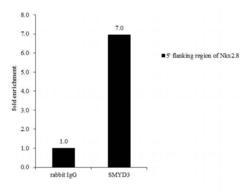
- Experimental details
- Cross-linked ChIP analysis of SMYD3 in HepG2 chromatin extract using 5 µg of either normal rabbit IgG or anti-SMYD3 antibody (Product # PA5-31919). The precipitated DNA was detected by PCR with primer set targeting to 5' flanking region of Nkx2.8.
- Submitted by
- Invitrogen Antibodies (provider)
- Main image
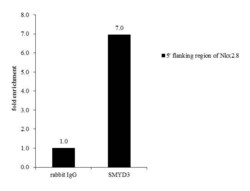
- Experimental details
- Cross-linked ChIP was performed with HepG2 chromatin extract and 5 µg of either normal rabbit IgG or SMYD3 Polyclonal Antibody (Product # PA5-31919). The precipitated DNA was detected by PCR with primer set targeting to 5 flanking region of Nkx2.8.
- Submitted by
- Invitrogen Antibodies (provider)
- Main image
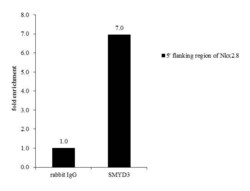
- Experimental details
- Cross-linked ChIP was performed with HepG2 chromatin extract and 5 µg of either normal rabbit IgG or SMYD3 Polyclonal Antibody (Product # PA5-31919). The precipitated DNA was detected by PCR with primer set targeting to 5 flanking region of Nkx2.8.
Supportive validation
- Submitted by
- Invitrogen Antibodies (provider)
- Main image
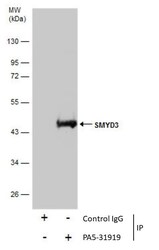
- Experimental details
- Immunoprecipitation of SMYD3 was performed in 293T whole cell extracts using 5 µg of SMYD3 Polyclonal Antibody (Product # PA5-31919). Samples were transferred to a membrane and probed with SMYD3 Polyclonal Antibody as a primary antibody and an HRP-conjugated anti-Rabbit IgG was used as a secondary antibody.
- Submitted by
- Invitrogen Antibodies (provider)
- Main image
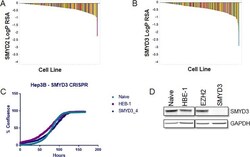
- Experimental details
- Fig 5 Gene ablation techniques show no dependence on SMYD2 or SMYD3 for cancer cell proliferation. Waterfall plot representing LogP RSA scores for sgRNAs targeting A) SMYD2 and B) SMYD3. 313 cell lines were infected with a library of 6500 sgRNAs targeting 600 different genes. LogP RSA scores represent depletion of guides from an infected cell population. Each bar represents a different cell line. Bars are colored by cancer subtype. C) Percent confluency of Hep3B cells infected with CRISPR viruses containing CAS9 and sgRNAs targeting HBE-1, EZH2 (negative controls) or SMYD3. Cell density was evaluated using an Incucyte Zoom. Growth curves were initiated 24 days following virus infection and puromycin selection. Plotted data is the average of three biological replicates. Error bars represent standard deviation (not readily visible on scale). D) SMYD3 western blot of lysates derived from Hep3B cells infected with CAS9 and SMYD3 sgRNA. Parental Hep3Bs and Hep3Bs stably infected with HBE-1, EZH2 (negative controls) or SMYD3 were lysed and probed for SMYD3 levels by western. GAPDH levels were evaluated as a loading control.
 Explore
Explore Validate
Validate Learn
Learn Western blot
Western blot Immunocytochemistry
Immunocytochemistry